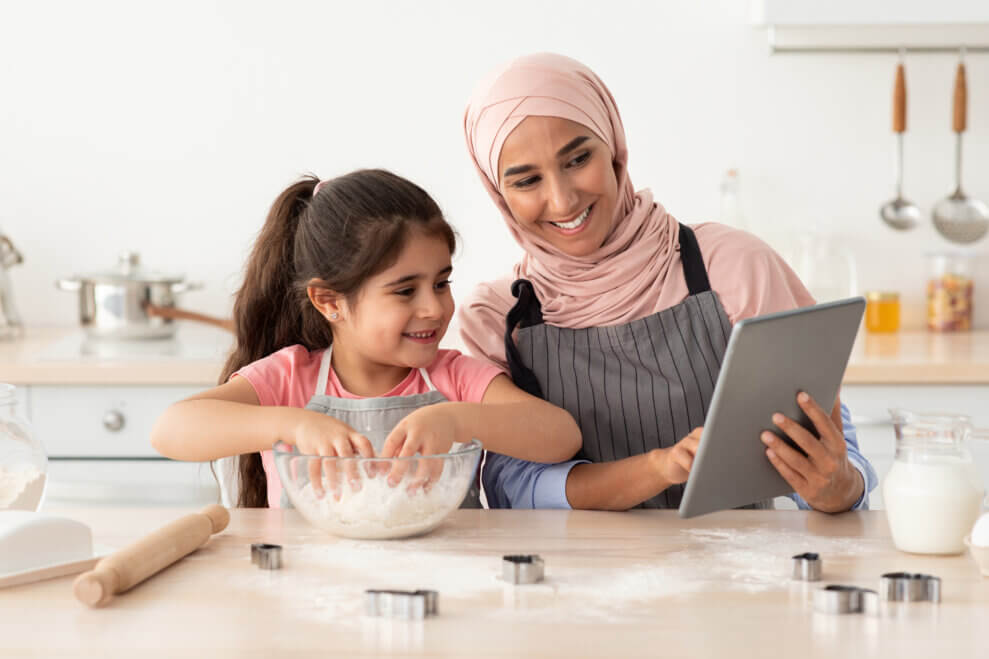
How much screen time should kids get?
Just the other day, our big television screen stopped working. No shapes or colours danced across its surface. It loomed silently over us every time we walked through the living room. At first my kids were in denial. They tried every strategy to resurrect the large screen, but no luck. When I declared it was truly broken, my kids were angry. How dare the TV die! They asked me to buy them a new one, and I said no. They asked me to fix it, and I said I’d look into it. I caught them sitting on the couch staring despondently at the black television. My toddler kept running into the living room yelling “Show-show! Oh nooooo!” and bursting into tears. The whole situation was comical and eye-opening. In the end, the TV did get fixed and those long three days without our big screen TV taught me a few things about screens and kids.
If you’re reading this article, I’m going to hazard a guess that you have some concerns about your kids’ screen time. You aren’t alone. According to the Canadian Paediatric Society, three-quarters of Canadian parents are worried about the amount of time their kids spend on screens. Let’s be honest, screens are an amazing form of technology. We use them to work, learn, connect, relax, and play. Despite how useful and accessible screens are, it’s good to know how they can potentially benefit or harm our kids.
The possible benefits and potential risks of screen time for kids ages 0 to 12
With screens being so common today, more research is being done on how this technology is affecting kids. The results? It’s a mixed bag. There are possible benefits and potential risks depending on how the screen is used and for how long.
To help untangle some of these pros and cons I have delved into two recent documents on screen time published by the Canadian Paediatric Society and have summarized their findings below. If you’d like to delve into the research a bit more you can find the documents here and here.
Possible benefits of screen time for kids
Whenever new technology makes its appearance there are always naysayers, and screens have had their fair share of negative press when it comes to kids. However, screens have some unique benefits for kids. When preschoolers (ages two to five) use quality educational content on screens it can help them with early language development, social skills, creative play, and even physical activity. Also, as most parents know, a screen is also a helpful tool as a distraction during medical procedures or a long wait like going on a plane.
For kids ages six to 12, educational content and apps have been shown to improve mathematics and literacy skills, increase knowledge about various topics, and provide immersive learning opportunities. Screens can also help develop positive relationships with peers and educators through collaborative learning experiences and games. Interestingly, an appropriate amount of recreational screen time—an hour or less a day—can lower the risk of depression.
As a mother of five, I’ve seen first-hand how great screens can be for learning. My kids have accessed various educational apps and content on screens to learn how to read, grasp math concepts, take virtual art classes, try science challenges, and learn about unique topics from ocean life to Minecraft builds. They also use screens to keep in touch with family and friends. Screens can have a powerful positive impact on kids!

Potential problems of screen time for kids
Despite the potential benefits of screens, there are some well-documented problems that can arise when children are exposed to a high amount of screen use. Preschoolers (ages two to five) seem particularly sensitive to a high exposure to screens. Research has shown that too much screen time can delay language development, decrease emotional regulation, affect the ability to focus, increase sedentary behaviour, and cause sleep problems in preschoolers. It can even change the shape of their eyes and cause nearsightedness.
For kids ages six to 12, high amounts of screen time can cause depression, negatively impact behaviour, and decrease physical activity. There’s also a concern that solitary screen use can increase the risk of exposure to harmful content.
I’ve experienced some of these problems first-hand with my own children. While I was pregnant with my fifth baby, I was so exhausted. I used screens to “babysit” my very busy two-year-old more than I’d like to admit. The fallout was not pretty. She developed a reliance on screens practically overnight, and wouldn’t even eat her food unless a show was on. There were tantrums and tears the moment a screen was turned off. It was a shockingly quick descent into mayhem. However, I am happy to report that with mindful management my toddler was weaned from too much screen time quite quickly.
How much screen time should kids get?
According to the Canadian Paediatric Society, the recommended screen times for children between the ages of zero to 12 are listed in the table below.
| Recommended Screen Time | |
| Ages 0 to >2 | No screen time. Exceptions: Video chat or story read-out-louds. |
| Ages <2 to 5 | 1 hour or less each day |
| Ages <5 to 12 | 2 hours or less each day |
If your child is consuming more hours of screen time than the recommended amount, don’t be discouraged. I’ve been there more times than I can count. Below I’ve included a helpful list of recommendations for managing your child’s screen time in a mindful way. I use many of these suggestions in my own home and they work well, so I hope you find them helpful as well.

Suggestions for managing screen time
Parents and caregivers have an incredible opportunity to positively impact their kids’ lives through the ways they manage screen time. The Canadian Paediatric Society offers “Four Ms” to help parents, caregivers, and educators manage screen time for their children. The four Ms are: minimize, mitigate, (be) mindful, and model. Here are some suggestions on how to put the “Four Ms” into practice in your own home.
1. Minimize screen time
The first step to helping your child have a healthy relationship with screens is to manage daily screen time for your child. Most devices have parental controls that allow you manage how long your child uses a screen and what they can access. For example, the Nintendo Switch has a parental phone app that allows you to set daily time limits that automatically shuts the device down when that time is reached. It’s great! To learn more about parental controls and setting limits on various devices, just do a quick internet search. Here are some other suggestions for minimizing screen time for your child:
- Make sure there are no TV shows playing in the background throughout the day or evening.
- Prioritize screen-free meal times.
- Avoid screen time one hour before bed.
- Limit screen time in public places.
- Resist the urge to use screens to “babysit” your child.
For more ideas for minimizing screen time here are:
- Easy Habits for managing kids’ screen time
- 5 tips for limiting screen time without conflict
- 5 easy locations to make screens off-limits
- Simple tools to help parents manage screen time
2. Mitigate risks of screen time
Screens can provide amazing experiences, resources, and information, but they also have plenty of harmful content that your child can accidentally stumble upon. For these reasons, I’m a firm believer in doing what I can to mitigate the risks of my children encountering harmful content on screens. It’s also important to monitor how your child is reacting to screen use. Here are some helpful ways for mitigating the risk of screen use and monitor your child:
- Use parental controls and privacy settings on any device your child uses.
- Check media ratings for age-appropriate apps, video games, and shows.
- Be a part of your child’s media lives.
- Know your child’s passwords for apps and devices.
- Discuss safe screen use with your child.
- Co-use screens with your child.
- Minimize exposure to advertising.
- Pay attention to the messaging.
- Place screens in common areas of your home.
- Monitor your child for behavioural problems related to screen use (negative emotions, oppositional behaviour).
3. Be mindful about screen time
Approaching screen time mindfully means being aware how and when screens are used for the whole family. In my home, each child has the same time limit for using screens as entertainment (video games, YouTube, shows, etc.). We have also made a family commitment to take a break from screens on Sundays to spend face-to-face time together. Here are more helpful ways to approach screen time mindfully with your child:
- Schedule in screen-free time throughout the week.
- Prioritize educational, social, and active screen use.
- Come up with a family media plan.
- Take a break from screens when they are charging.
- Leave screens at home and explore the outdoors together.
4. Model healthy screen use
Kids are great imitators. They like to copy us—the good and the bad. My child went through a phase of saying “Hey you!” to my husband and I as a way of getting our attention. I thought it was a bit rude and wondered where he had picked up the habit. It took me a day or two to realize that I was using the same words to get his attention! When it comes to screens our kids are very perceptive of the way that we use them. That’s why it’s really important to model healthy screen use. Here are some tips for modeling screen use for your child:
- Be mindful or your own screen use habits.
- Put your smartphone away when your child is in the same room as you.
- Keep your phone tucked away during meal time.
- Avoid checking your phone while driving.
- Talk about how you use screens mindfully.
Wrapping it up
Screens aren’t going anywhere. That being said, we parents and caregivers are in the perfect position to help our children learn how to use screens in a mindful way. By starting early we can help our kids learn lifelong habits that will help them live healthy, happy and active lives.
If you have any questions or comments about this article, please feel free to use the comment section below.






Good advice
Thank you, Tom! Appreciate the comment.
What are some free good educational apps recommended
Try this list! activeforlife.com/activ…-for-kids/